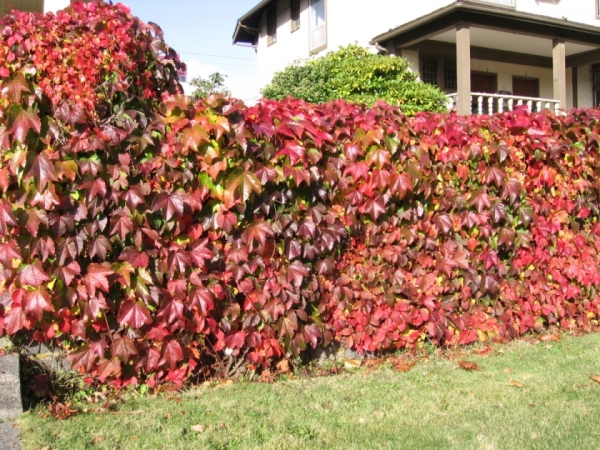Among the current trends in the landscape design of private plots are living hedges. The most harmoniously looks object with the girlish grapes lashing along the supports. And although the berries are not valuable, the intensively developing whip becomes a real decoration of the yard. In this review you will get acquainted with the description of the varieties of this plant, how and where to plant and the features of care.
Table of contents
Description of girlish grapes
The maiden grapes belong to the perennial crops of the family of grapes, the tree-like liana is from North America. Around the world, the plant is used as a decor when designing the landscape of private households, parks, playgrounds, etc.
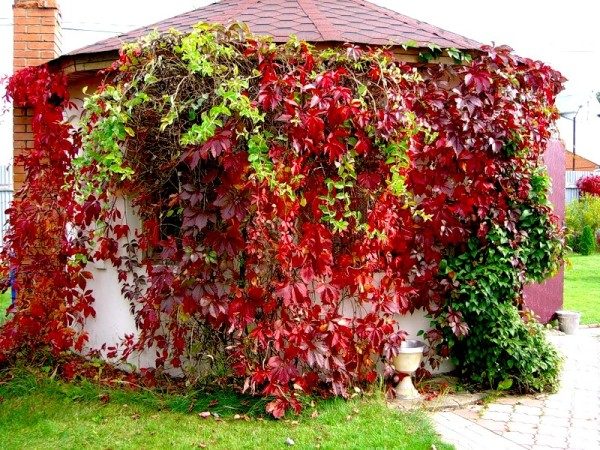
The stem and branches develop fairly quickly, reaching a length 20or even 30 m During the first year after disembarkation, the young shoot increases in size to 5 m.
Brief characteristics of culture:
- corymbose inflorescences, small yellow green color;
- on the vine there are antennae with 5-8 branching, with the help of them, the lash clings as it spreads vertically;
- palmatology leaves of 5 leaves, color from rich green to red shades;
- fruit 5-7 mm in the diameter of dark blue color (non-edible for humans due to the content of oxalic acid);
- flowering period - the end of spring.

Berries plants are used as feed for birds.
Differences from other species
This type of grape is different from the table and wine varieties of its decorative. Liana is used mainly for the design of the landscape, as a private household, and urban parks. Culture gained its popularity due to the following predominant qualities:
- decorative characteristics;
- high resistance to various diseases and insect attacks;
- unpretentious care;
- available breeding methods;
- intensive development of the whip;
- hypoallergenic shrub;
- phytoncidal properties of the plant.
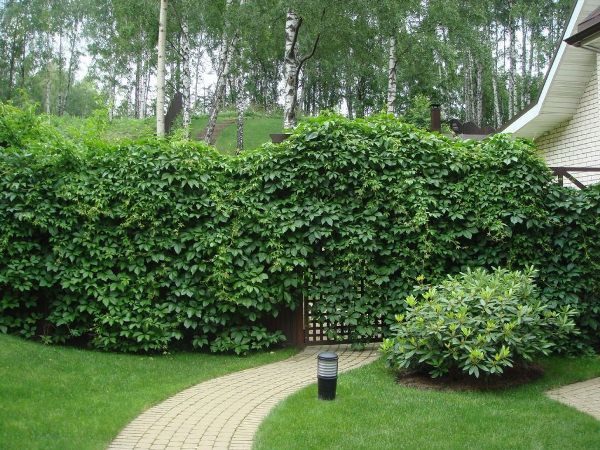
When used as a hedge or for zoning the space at the site is protected from gases and dust coming from the street roads.
Most popular varieties
Among the most popular varieties are two varieties of girlish grapes, which are most often used for landscape design.
Virginian (five leaf)
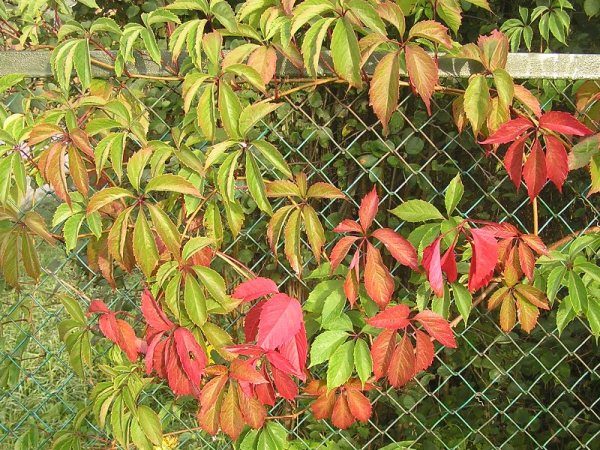
The five-leafed plant reaches the length of branches up to 20 m, it is characterized by green foliage, acquiring a reddish tint closer to autumn. Young shoots in the first year of life grow to 2,5 m, clinging to the spread of all that is possible with their mustaches and suckers. Sheets look like chestnut greens. In July, comes the abundant flowering of bushes, they are thickly covered with inconspicuous small flowers of yellow-green color. Already in the first decade of August small clusters with dark blue berries are seen on the branches of the vines, which often become a delicacy of birds.
Ivy (triostrenny)

The grade received the name thanks to similarity of a leaf with greens of an ivy. Culture is very widely used as a decoration in Asian countries: Korea, China, and Japan. The color of leaves depends on the variety. The golden liana is characterized by the presence of yellow specks on the green surface, the purple subspecies has a dark maroon coating, and the Vicha grape is distinguished by small glossy green leaves that become bright orange in autumn. Thanks to the magical reincarnation and unique beauty, Witch is most in demand among designers and gardeners.
Planting in the open ground in spring and autumn
There are no definite dates for planting girlish grapes, as the plant adapts well in all conditions except frost. The most favorable periods for good survival of shoots are considered to be autumn (September, October) and spring (April, May). The process of planting a climbing plant is better to plan in the morning or evening, when the sun's rays are not so active.
A place under the bush will not have to choose for a long time, the culture develops well, regardless of the intensity of sunlight. Well, if the soil is fertile, but also on difficult soils, where there is a layer of clay, the root system will grow stronger and stronger.

It is necessary to prepare a sapling with 60x60 cm of parametres. At the bottom are broken bricks or crushed stone for drainage. The next layer is filled with sand (at least 20 cm), and then a mixture of the following components:
- half a bucket of fertile garden land;
- half a bucket of compost or humus;
- half a bucket of peat;
- a glass of wood ash.
When determining the location of the pits between the landings, it is recommended to observe interval not less 80 see between plants and 1 m from the basement of the building.
After filling the sapling with earth, it is necessary to water the bush abundantly.
Features of care, preparation for winter
The first time you need to regularly carry out watering young escape. Adult plant moisturize no more 3-4 once a season. Unpretentiousness to moisture due to the deep penetration of root processes in the soil, where he eats natural water reserves.
Regular care is required for the formation of the bush. The plant must be pruned, and also in need of trimming, garters, installation of supports for the direction of weaving branches.However, it is worth considering that only young saplings need a garter when the antennae have not yet developed enough for a strong fixation to the surfaces.
The first year of life of the seedling is characterized by rooting and the beginning of the growth of the whip. Immunity is not sufficiently strengthened in such a short time, so for the winter young gardeners are advised to shelter young culture in order to prevent freezing.
To stimulate the development of branched parts and foliage, it is recommended periodically (2-3 times per season) to apply fertilizer to the soil. The simplest option is considered to be watering a solution of wood ash. You can also use Kalimagneziya, nitroammofosku, Aquamarine.
The maiden grapes are prone to gradual elevation in the soil and the exposure of the rhizome. If you notice that the roots of the plant begin to protrude above the ground, be sure to sprinkle on fresh soil and slightly tuft the vine. Usually this procedure is carried out in the autumn, as part of preparing the garden for the winter.
Breeding rules for ornamental grapes
Decorative grapes are propagated in the following ways:
- seeds;
- using layering;
- cuttings.
Seeds
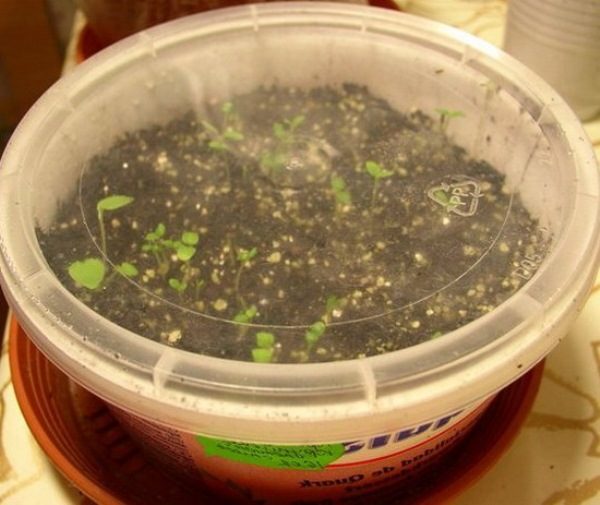
The process of growing shoots from seed takes a long time. In the spring or in the fall (in October), grains, which have undergone pre-hardening and soaking, are immersed in a container with a loose soil. Immersion depth is 1 cm. A film is covered on top of the container and a temperature regime of no more than 5 ° is observed before the shoots are germinated. After about a month, the first shoots will appear, and when they reach a height of 10 cm, it is necessary to transplant the shoots into the open ground, if the transplant falls out in the spring, or into a separate pot for further wintering.
Layering
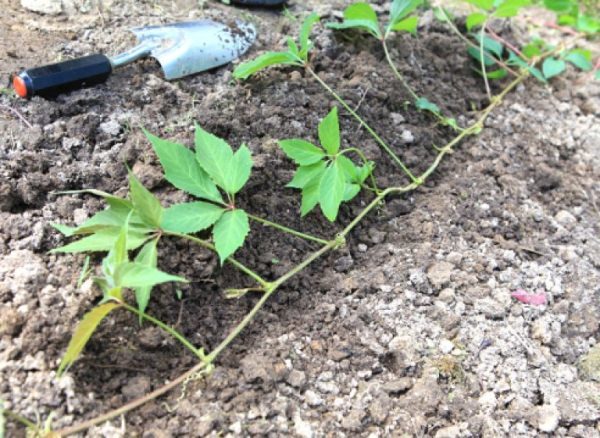
The layers of the plant multiplies very willingly and actively. To do this, select the branches, whose age is approximately 2-3 of the year. Pressing them to the ground, you need to powder the soil in the place where the rooting of the shoot is planned. Fix the top with a garter or support vertically. The first days of watering is important and the lack of drafts. The roots form very quickly, after a month you can observe a well-developed root system. After the rooting of cuttings, the junction of the bushes should be cut off with a pair of shears (a knife with a sharp blade).
Cuttings
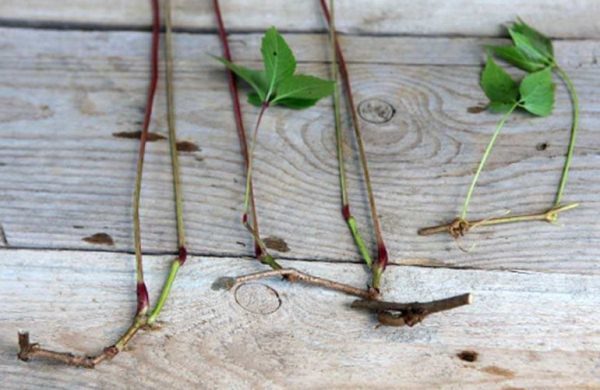
Petioles are harvested in the fall and spring until the juice moves. The length of the workpiece should be approximately 23-30 cm. It is also important for the further growing season the presence of buds (4-5 pcs.). Planting is carried out in loose soil with a dive in it by half or third, so that 2-3 buds remain on top. Before rooting the germ, regular watering and protection (shading) from the scorching sun is important.
Diseases and pests
Decorative culture has a strong immunity, so rarely affected attacks pests or diseases. Sometimes on the leaves you can see the aphids, to get rid of that will not be difficult. It is enough to first crush the insects with water, then treat the shrub with a soap solution with alcohol (in a 3: 1 ratio).
High aesthetic value, unpretentious care and resistance to various diseases have made girlish grapes popular among gardeners and designers involved in the design of landscapes. Dense foliage will decorate the yard, create shading in the recreation area, hide the unsightly walls of the outbuildings. A hedge will retire to any corner of the site and prevent the penetration of street dust from the roadway.
